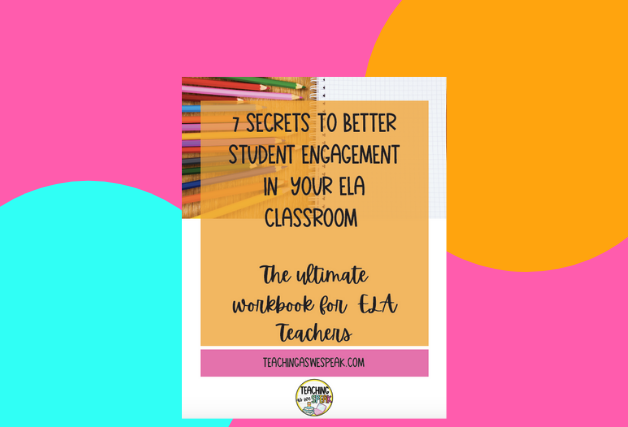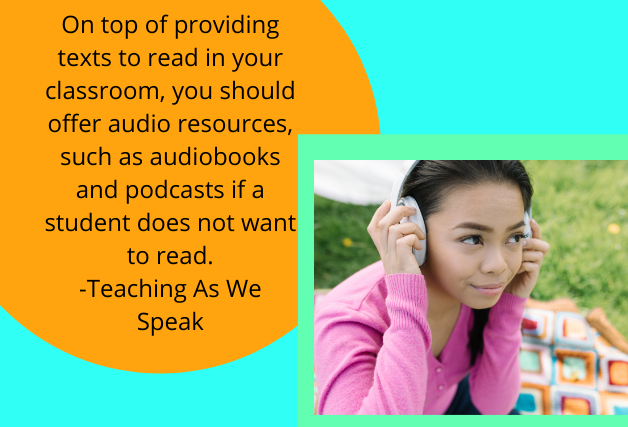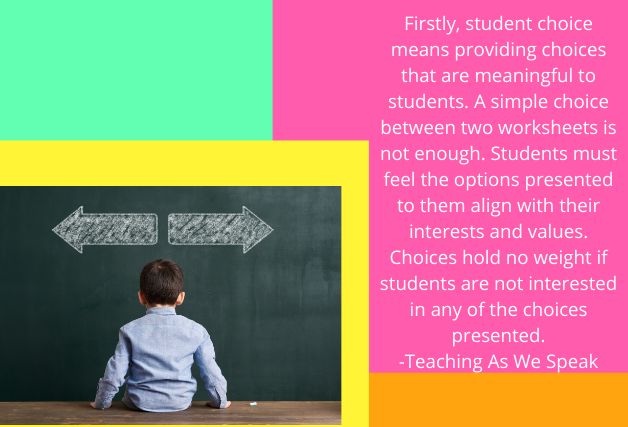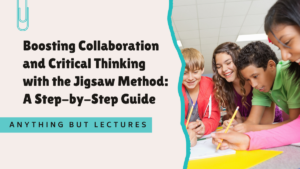Offering opportunities for student choice in the classroom is one of the best ways to improve student engagement. If students are presented with meaningful, relevant, and manageable choices, they will feel that they have a say in their learning.
But where to fit in more opportunities for decision making in the classroom for you students?
Be sure to watch the video below, posted from my Facebook group The Teacher and Student Engagement Convo
I have included 5 ways to allow for more choice in the classroom.
Also, be sure to get my guidebook The 7 Secrets to Better Student Engagement in your ELA Classroom for a more full list of student choice opportunities.

Empower Student Choice
Before getting into WHERE to include student choice, first, we must talk about HOW to bring student choice to your students.
If done properly, student choice will empower students to be more engaged learners. As a result, students will want to be more present in the classroom.
However, if students are shown a half-fast attempt at giving them choices, you will leave them overwhelmed. Even worse, they may not even realize they were presented with choices carefully chosen by you, the teacher.
Firstly, student choice means providing choices that are meaningful to students. A simple choice between two worksheets is not enough. Students must feel the options presented to them align with their interests and values. Choices hold no weight if students are not interested in any of the choices presented.
In order to create the right options, you must know your students. Check out my guidebook on 7 Secrets to Better Student Engagement for ways to get to know your students.
Secondly, the students must feel that they are capable of choosing within the parameters you set for them. Having to choose between 10 tasks (which they’ve never seen before) within 30 seconds is not a realistic expectation.
Instead, try to give students a handful of relatively familiar tasks. Make sure to visually and audibly list the choices, and to go through each one in-depth. Better yet, tell students before explaining each selection that students will be given the choice, and thus they should prepare to make a decision.
Moreover, for students who struggle with more freedom and choice, give these students the options before the class, in order to give them extra time to prepare.
**Tech Tip! If you are teaching on ZOOM, present options to students and indicate a breakout room number that the activity will be held. Students can either put in the chat or hold up the number of fingers to indicate the activity/breakout room they would like to go to.
Thirdly, keep student relationships into consideration when selecting tasks for students-because they definitely will. Many students will want to make choices based on what their friends choose. There may be one leader in the class that will make a choice, and the rest of students will follow suit.
This is ok!
It is possible a student will make a choice because their best friend did so, only to realize halfway through the activity that they have zero interest in the task and want to change. This is up to you whether you want to allow this. I personally would, as the student is making a step towards more autonomy.
To plan ahead for friend choosing, do not limit the number of people who can choose a certain task. If four friends choose one activity and the fifth friend is left out and is forced to choose a different activity, already this student is going into the activity with a negative mindset.

Now that we know how to include student choice, we need to look at where to bring more choices into the classroom.
Below is a list of 5 areas to bring more choices to students. Click here to get a complete list!
1. Topics as Student Choice
Instead of giving students topics to research, allow them to pick and choose what they want to learn about.
You can have the topic in mind, such as outer space or the water cycle. However the direction the project takes should be student-led.
For example, let’s say you are planning on teaching a unit about the history of animals in zoos. On the first day, you show them a video of a gorilla in a zoo cage. All of a sudden, your students are talking about the movie The Planet of The Apes. You try to veere back to the topic you had planned, but they are way more interested in discussing the movie. They are asking who created the movie, why they created it, the inspiration, etc…
A good teacher would identify the passion coming from students and latch onto it!
In other words…
Change the dang topic! Allow your students to research this questions and present their findings in a meaningful way!
If you want to leave the topic completely open to your students, consider introducing passion projects to your students. I wrote an entire article about passion projects, which you can find by clicking here!
Allow students to have a writing journal that is for them to write freely. This journal is not to be marked and is used as a safe space to get creative!
***Bonus tip! If you do use passion projects in your classroom, tell students to use this journal as a way to get ideas for topics for their projects
2. What is Flexible Seating?
Flexible seating has become a popular trend in the teaching world. Flexible seating is a seating arrangement style that provides choices in where the students sit, the seating type and with whom students sit with.
If you are willing and eager to hit the ground running with flexible seating, there are tons of seating options you can buy at stores such as Lakeshore Learning.
However, if you are looking to start small, here are a few options:
-Allow students to select where they sit and with whom
-Provide different seating arrangement options. For example, arrange some desks in pairs, in groups and separated from other desks for those that like to work independently.
If you don’t have the money to go out and buy 10 wobble seats today (who does?), then start off with the last two tips listed above!
3. Choosing a text
Allow students to pick among these different options when selecting a text for research, for an early-finisher activity or simply for pleasure.
- Class Library
If possible, have an area in the classroom where students can select their own text to read. Include various types of texts, such as magazines, novels, graphic novels, cook books, etc…
Make sure to include a suggestion box or board where students can recommend texts to include in the class library. The class could even hold a fundraiser to collect money to buy these suggested books or resources.
Class libraries are not always financially possible. However bringing students to a school library and having them share their choices with you is just as powerful.
***DistanceLearning tip! If you are teaching from home, have students select one reading material from home to share with the class.
- Text-audio or visual
On top of providing texts to read, you should offer audio resources, such as audiobooks and podcasts if a student does not want to read.
You can read all about how to implement podcasts in the classroom by reading my blog post TEACHER TIRED? GIVE STUDENTS THIS ACTIVITY TO KEEP THEM QUIETLY ENGAGED
Check out my Podcast in the Classroom Complete Bundle

4. Audience
When students are writing, presenting or creating something, students should always keep the audience in mind.
This is something that can get overlooked or forgotten by students, especially when they always assume that their audience is solely you, the teacher.
Give students the chance to get creative with who their audience is.
Take a student who is creating a graphic novel because they are passionate about Marvel Comics. Imagine how creative and engaged they are when producing their work for their teacher, who shows no enthusiasm for comic books. Now compare that to their engagement level when they imagine creating a masterpiece for an audience at Comic-Con.
5. Goals
Finally, students should have a say in terms of their goals within the classroom. Students are used to being told by their teachers what they need to be working on. It is important to communicate your goals with your students.
However, you are missing out on opportunities to teach accountability and goal-setting if you are not allowing your students to set their own goals.
What I like to do is have students complete a piece of work completely independently. This could be in the form of a writing piece if you are setting writing goals, a reading response activity for writing and a presentation for oral communication skills.
Then, I give students written feedback on their work. But I also ask a question at the bottom of the rubric for students to answer the question “ what do you feel you could have done to improve your work.”
This may seem foreign to your students at first, but eventually they will be used to this question.
***Bonus tip! Use the same rubric for writing, reading and oral communication. This way, students will know what you are using to evaluate, and they will begin to use the same language that they see in their evaluations.
BEFORE YOU GO! Be sure to get your FREE guide, The 7 Secrets to Better Student Engagement.




12 thoughts on “Student Choice In The Classroom-5 Ways To Include it more!”
Thank you so much for this! I havent been this moved by a blog for a long time! Youve got it, whatever that means in blogging. Anyway, You are definitely somebody that has something to say that people should hear. Keep up the good work. Keep on inspiring the people!
Thanks so much! I truly appreciate that! Be sure to check out my free workbook for more tips and tricks for the classroom!
Hi – in truth huge site you have created. I enjoyed reading this posting. I did want to publish a remark to tell you that the design of this post is very aesthetically delightful. I used to be a graphic designer, now I am a copy editor. I have always enjoyed functioning with information processing systems and am trying to learn code in my free time.
Trusting to make the right decisions can be tough. It can take many people a long time to build a strong moral system. It doesnt really just happen if you know what I mean.
This is some good stuff. It took me some time to locate this blog but it was worth the time. I noticed this website was buried in google and not the first spot. This internet site has a lot of good stuff and it doesnt deserve to be burried in the searches like that. By the way Im going to save this site to my favorites.
Hi there, I just now wished to inform you that your Feed is apparently broken. Or its just that I cant see where it is Where can I sign up?
Hi, do you mean to sign-up for the freebie? Did you try clicking the link?
Very nice blog post. I certainly appreciate this website.
Continue the good work!